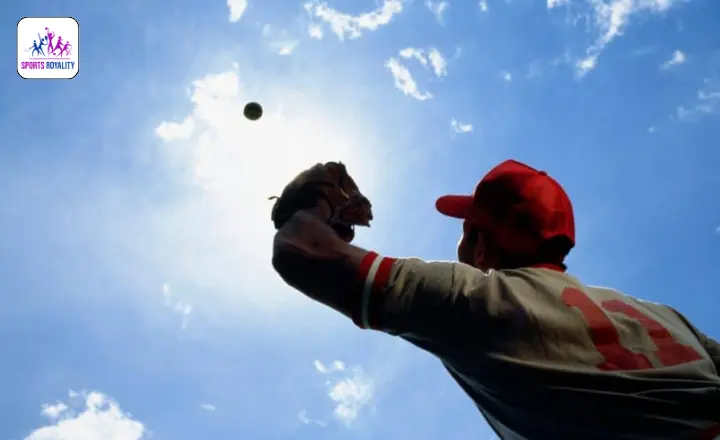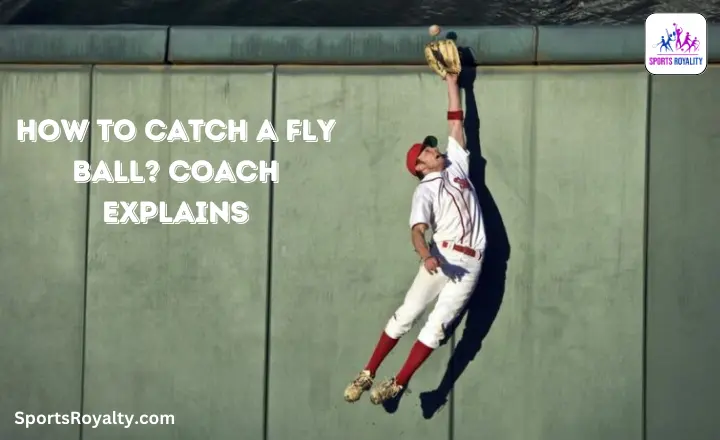Have you ever watched professional baseball players gracefully glide across the field, effortlessly catching soaring fly balls? It seems like second nature to them – but for many aspiring players, catching a fly ball can be a nerve-wracking challenge. Whether you’re new to baseball or simply looking to improve your skills as an outfielder, there’s hope yet! In this article, we will explain the true tips and tricks for mastering one of baseball’s most essential skills How to Catch a Fly Ball. Get ready to take your game to new heights with these insider secrets from Coach Johnson himself.
How to Catch a Fly Ball Hit?
Catching a fly ball hit in baseball or softball may seem simple, but it requires a combination of focus, skill, and timing. Some steps are given Below:
Read A Fly Ball Hit
When it comes to playing baseball, one of the most important skills every player must master is being able to read a fly ball hit. This skill allows outfielders and infielders alike to anticipate where the ball will land and make a play accordingly.
Step 1: Sight through the Cap’s Bill
To sight through the cap’s bill effectively, you need to keep your eyes focused on the ball as soon as it leaves the bat, following its trajectory with precision. By tilting your head down and peering through the bill of your cap, you can create a clear line of sight that helps block any glare from the sun or stadium lights, giving you an advantage in tracking the ball’s flight.
While relying solely on your peripheral vision may seem tempting when trying to spot a fly ball, using this technique can greatly enhance your ability to track its movement accurately. By narrowly focusing your view through the cap’s bill instead of looking directly up at the sky or field lights, you minimize distractions that might hinder your judgment.
Sideway glances can cause blurred vision due to limited eye stability maintaining focus downfield prevents any visual disorientation caused by moving objects or other players running around.
Step 2: First Move Should Be Backward
Many young players in baseball team are often taught to react by moving towards the ball right away, but experts argue that the first move should actually be backward. By taking a step back, players create valuable time and space to accurately judge the trajectory of the ball and determine its speed.
Moving backward initially also allows players to establish a strong position from which they can then react swiftly in any direction required. This approach not only gives fielders a better chance at catching high-flying balls but also helps prevent any potential misjudgment or collision with teammates who may also be attempting to catch the same ball. The idea of moving backward as your first instinct challenges conventional wisdom and emphasizes strategy over impulse. It is an important aspect of defensive play that requires practice and focus.
Step 3: Make Your Adjustments
Once you’ve read a fly ball hit, it’s time to make your adjustments. This crucial step can be the difference between making an incredible catch and watching the ball sail over your head. Quickly assess the trajectory of the ball and its speed. Use this information to determine whether you need to take a few steps forward or backward, or if you should move to your left or right.
Another key adjustment is understanding the wind conditions. A strong gust can drastically change the path of a fly ball, so be sure to account for this when positioning yourself. Keep an eye on your surroundings are there any obstructions in your way? Anticipating potential obstacles will allow you to plan ahead and make necessary adjustments in order to successfully track down that fly ball.
Making these adjustments is not about guesswork but utilizing all available information at hand. By analysing the flight of the ball, taking wind into consideration, and being aware of potential obstructions, you can position yourself optimally for catching that fly ball with style and precision.
Run Towards a Fly Ball

When you commit to running towards a fly ball, you are not only showcasing your physical abilities, but also your determination and mental strength. You have to trust your instincts and make split-second decisions while constantly adjusting your position to catch the ball at its peak. Running towards a fly ball requires focus and concentration in order to anticipate its trajectory accurately.
Method 1: Forward Running
The method of forward running can truly make all the difference. Rather than waiting for the ball to come to you, this technique involves taking off towards the incoming ball with full force. Not only does it give you an advantage in reaching the ball faster, but it also allows for better control and positioning. By initiating a forward run, players can adjust their speed and angle based on the trajectory of the flyball, providing them with a higher chance of making that crucial catch.
One key aspect of forward running is maintaining visual focus on the flyball throughout the entire process. This means keeping your eyes locked onto its movement from the moment it’s hit or popped up into the air. It may sound simple, but often players tend to divert their gaze or lose sight of it momentarily while in pursuit. By staying fully engaged and tracking its flight path consistently, you’ll be able to position yourself accurately under the ball and execute that elusive catch effortlessly.
Method 2: Backward Direction Running
There’s an unconventional yet effective method that some players have started embracing running in the backward direction. It might sound counterintuitive, but this technique offers unique advantages that can give you an edge on the field.
One major benefit of running backward while tracking a fly ball is improved visibility. By facing away from home plate, your line of sight is clearer, allowing you to better judge the trajectory and depth of the ball. This gives you a crucial advantage when making split-second decisions on where to position yourself for the catch.
Running backward engages different muscle groups compared to forward sprinting. The sudden change in movement pattern forces your body to adapt and work harder on maintaining balance and coordination. your overall agility and spatial awareness increase significantly over time with regular practice.
Team calls
One key aspect of successful team calls is the art of catching a fly ball hit. In other words, it’s about being responsive and adaptable to unexpected situations or questions thrown one’s way during a call. Just like fielding a baseball hit out of nowhere requires focus and quick reflexes, being able to address unanticipated queries or challenges in real-time during team calls can make all the difference in keeping conversations flowing smoothly.
By honing this skill, teams can foster an atmosphere where no question goes unanswered, and no problem is left unresolved ultimately leading to increased productivity and greater collective intelligence.
Cook n Catch
The Cook n Catch technique in baseball is an essential skill that every player should master. Before you can even think about making the catch, there are a few important steps to take.
Step 1: Before the Catch
The first step is all about positioning your body correctly. By ensuring that your feet are shoulder-width apart and facing towards the incoming ball, you are setting yourself up for success.
Another crucial aspect to consider before making the catch is keeping your eye on the ball at all times. It sounds simple enough, but it’s easy to get distracted by other players or lose focus for just a split second. By maintaining unwavering focus on the ball, you increase your chances of successfully tracking it and ultimately making the catch.
Step 2: During the Catch
During the catch is a crucial moment in baseball, as it sets the stage for what happens next. One technique that has gained popularity is the Cook n Catch method. This technique involves catching the ball while also simultaneously positioning yourself to make a swift throw. It requires precise coordination and split-second decision making.
The key to executing the Cook n Catch technique successfully lies in understanding the trajectory of the ball and adjusting your body accordingly. By anticipating where the ball will land, you can position yourself optimally to catch it and immediately transition into a strong throwing motion. This skill takes time to master but can be a game-changer as it allows you to quickly react and efficiently continue with gameplay.
Step 3: Ideal vs. Reverse Catch
When it comes to catching fly balls in baseball, there are two primary techniques: ideal catch and reverse catch. The ideal catch is the traditional method where the fielder runs towards the ball, positions themselves under it, and catches it with their glove facing up. On the other hand, the reverse catch involves running away from the ball while looking over your shoulder and catching it with your glove turned upside down.
Both techniques have their advantages and should be mastered by outfielders. The ideal catch allows for better control as you are moving towards the ball and can adjust your positioning accordingly. It also gives you a clearer line of sight as you track the trajectory of the fly ball. Those who opt for reverse catching argue that this technique allows them to maintain speed while keeping an eye on both the flight of the ball and their path on potentially uneven terrain or when running at top speed.
Best Baseball Drills for Fly Ball
One of the most exhilarating moments in a baseball game is when a player gracefully catches a fly ball. It requires precision, agility, and quick reflexes. To enhance these skills, there are several drills that players can practice to improve their fly ball catching abilities.
Dive Play Drill
One of the best baseball drills for mastering fly balls is the Crossover Drop Step drill. This drill focuses on improving a player’s first step and reaction time when tracking fly balls in the outfield. The key to executing this drill effectively is to start with proper positioning. As soon as the ball is hit, the player takes a quick crossover step with their lead foot while dropping their back foot into position. This technique allows the player to gain momentum and quickly change direction towards the ball.
Dive Play Drill
Dive play drill is a must-have in any baseball player’s practice routine. This drill not only focuses on improving defensive skills but also helps players gain confidence and agility when chasing down fly balls. It is crucial for outfielders to be able to make those spectacular diving catches that can change the outcome of a game.
One key aspect of the dive play drill is teaching players how to properly read the trajectory of a ball off the bat. By honing their ability to quickly analyse the speed, angle, and height of a fly ball, players can position themselves correctly before making their diving attempt. This drill emphasizes the importance of good body control and timing, as players need to time their dives perfectly in order to make a successful catch.
Wrapping Up
Catching a fly ball requires a combination of skill, focus, and practice. By following the steps outlined in this article we have discussed How to Catch a Fly Ball. anyone can improve their ability to catch fly balls on the baseball field or in any other sport that involves this skill. Remember to always keep your eye on the ball, position yourself correctly, use proper technique, and stay focused until the ball is securely in your glove. With dedication and perseverance, you will become a master at catching those challenging fly balls. So, get out there and start practicing today.
FAQs
How do I judge the distance of a fly ball?
Practice tracking the flight of the ball and learn to gauge its distance based on how quickly it appears to be approaching.
What should I do with my glove when catching a fly ball?
Hold your glove with the palm facing up and fingers spread open, creating a basket-like shape for easy catching.
What if there are other players nearby also trying to catch the same fly ball?
Communicate with your teammates using vocal cues or hand signals to avoid collisions and ensure one player takes control of catching the ball.

